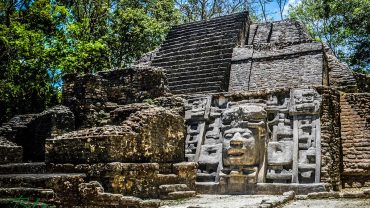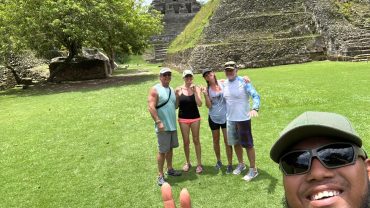-
Xunantunich was likely founded around 600 AD, during the Early Classic period of Maya civilization.
-
The site was originally known as “Stone Woman,” a reference to the legend of the “Stone Woman” spirit who was said to inhabit the area.
-
Xunantunich was a major ceremonial center and likely played a significant role in the political and religious life of the ancient Maya.
-
The site is home to several impressive structures, including several large pyramids and temples. The most famous of these is the “El Castillo” pyramid, which stands over 130 feet tall.
-
In addition to the pyramids, Xunantunich also has a number of other notable structures, including a ball court, a sweat bath, and several palaces.
-
Despite its importance, Xunantunich was abandoned sometime around 1000 AD, during the Late Classic period. The reason for this abandonment is not well understood, but it may have been due to a combination of overpopulation, drought, and social unrest.
-
Xunantunich was rediscovered by modern archaeologists in the late 19th century. Excavations at the site have revealed a wealth of information about the ancient Maya and their way of life.
-
In addition to the ancient Maya, Xunantunich was also home to a number of other cultures over the years. These include the Mopan Maya, who lived at the site in the late 19th and early 20th centuries, and the Kekchi Maya, who currently live in the area.
-
Visitors to Xunantunich can explore the site on their own or take a guided tour. The site is open to the public and there is a small entrance fee.
-
In addition to its historical significance, Xunantunich is also an important ecotourism destination. The site is inhabited by an array of wildlife from foxes, to howler monkeys to toucans and so much more.
- Belize Tours
- 17 Apr 2024
Belize Cave Tubing and Combination tours. The top 20 tours in Belize, read and book live.
- Uncategorized
- 01 Jul 2023
Stay One Step Ahead: Reserve Your Dream Trip with Belize Fun Tours
Are you planning a trip to the beautiful country of Belize? If so, one important aspect to consider is how you will experience the various activities and attractions this incredible destination has to offer. When it comes to exploring Belize, booking with Belize Fun Tours, Belize’s premier local tour operator, can provide you with numerous […]
- Belize
- 01 Jul 2023
The Mask Temple at Lamanai: A Glimpse into an Ancient Civilization Nestled within the archaeological site of Lamanai in Belize stands a remarkable structure known as the Mask Temple. Referred to as Structure 9N-56, this temple derives its name from the two imposing carved limestone masks that flank its main stairway. In this detailed article, […]
- Belize
- 27 Jun 2023
Luxury Escapes: Experience the Top 5 Resorts in Hopkins, Belize
Welcome to our comprehensive guide to the best resorts in Hopkins, Belize, where your dream getaway awaits. We will unveil the top-rated resorts that offer unmatched luxury, breathtaking views, and unforgettable experiences. Whether you seek adventure, relaxation, or a mix of both, our curated selection is designed to cater to your every desire. Discover the […]
- Belize
- 26 Jun 2023
Airlines Traveling to Belize: A Comprehensive Guide
re you planning a trip to Belize? As you prepare for your exciting adventure, one crucial aspect to consider is your mode of transportation. Flying to Belize is a popular choice, offering convenience and efficiency. In this article, we will explore the airlines that fly to Belize and the cities they depart from. So, buckle […]
- Belize
- 24 Jun 2023
Top Romantic Destinations for Your Belize Honeymoon
When it comes to planning your Belize honeymoon, you want to ensure that you choose the perfect destination for a romantic getaway. Belize, with its stunning landscapes, rich culture, and warm hospitality, offers an array of options that are guaranteed to create unforgettable memories for you and your partner. We will explore some of the top romantic destinations in Belize, highlighting their unique features and why they are perfect for honeymooners like you.
- Belize
- 20 Jun 2023
7 Unforgettable Excursions in Belize: Explore the Wonders of the Western Caribbean
Are you planning a Western Caribbean cruise and wondering about the best excursions in Belize? Look no further! Belize is a gem in the Caribbean, offering a rich tapestry of natural wonders, ancient ruins, and vibrant cultural experiences. From exploring ancient Mayan cities to immersing yourself in lush rainforests, Belize has something for everyone. In […]
- Belize
- 13 Jun 2023
Serenity Now: Why Belize is the Perfect Place at the Perfect Time
In these uncertain times, more and more people are searching for a destination that provides a sense of peace, tranquility, and natural beauty. Enter Belize – a small country nestled between Mexico and Guatemala, boasting Caribbean Sea coastline, dense jungles, and an incredible variety of wildlife. If you’ve been looking for the perfect getaway, now […]
- Belize
- 09 Jun 2023
Discover the Enthralling Caves of Belize: An Unforgettable Journey into the Heart of the Earth Deep in the verdant rain-forest of Belize, lie some of the world’s most captivating and awe-inspiring caves. The tapestry of geological splendor and rich cultural history make Belize’s caves not just natural wonders, but treasure troves of archaeological interest. The Subterranean […]
- Belize
- 06 Jun 2023
Why Belize Should Be Your Next Vacation Destination: Unearth a Hidden Paradise
Belize is a country brimming with vibrant wildlife, grand Mayan temples, turquoise waters, and beautiful beaches. As a vacation destination, it’s relatively unknown to the masses, yet it ticks all the boxes of an ideal tropical getaway. Here’s why Belize should be your next vacation destination.
- Belize
- 30 May 2023
10 Unbelievable Reasons You Need to Travel Belize Right Now!
10 Unbelievable Reasons You Need to Travel Belize Right Now! When you think of breathtaking beaches, diverse wildlife, and a vibrant blend of cultures, which destination comes to your mind? If you haven’t considered Belize yet, then this article will give you unbelievable reasons why your next adventure should be to travel Belize. 1. […]
- Belize Tours
- 02 Jan 2023
“Exploring the Crocodile City: A Journey to the Ancient Maya Ruins of Lamanai”
Lamanai is an ancient Maya city located in the Belize District of Belize. It was a major ceremonial center and has a number of notable pyramids and other architectural structures. The name Lamanai is derived from the Maya language and means “submerged crocodile,” a reference to the many crocodiles that inhabit the nearby New River. […]
- Belize Tours
- 01 Jan 2023
If you’re visiting San Pedro Ambergris Caye in Belize and are looking for a unique and memorable adventure, consider taking a tour of the Actun Tunichil Muknal (ATM Belize) caves. Located in the Tapir Mountain Nature Reserve, the ATM caves are an ancient sacred site that was used by the Maya for ceremonial purposes. The […]
- Belize
- 29 Sep 2025
EF Tours vs Local Belize Experts
Why Going Local Matters, Avoid The Middleman Trap: Why Your EF Tours Belize Trip Might Not Be What You Expect (And Why Booking Direct is Better) EF Tours vs Local Belize Experts Belize. The name itself conjures images of lush, emerald rainforests teeming with exotic wildlife, the mysterious silhouettes of ancient Maya temples piercing the […]
- Uncategorized
- 17 Aug 2025
Discover Belize: The Ultimate Guide to Exploring Paradise on Earth Imagine a place where lush jungles meet pristine beaches, and vibrant coral reefs teeming with marine life invite you to explore. Welcome to Belize, an enchanting gem nestled in Central America that promises an unforgettable adventure for every type of traveler. From the ancient ruins […]
- Belize
- 05 Aug 2025
Spirit Airlines Launches New Nonstop Flights to Belize
Bound for Belize: Unlocking a Caribbean Gem with Spirit Airlines’ New Nonstop Service The allure of Belize has long captivated adventurers, nature enthusiasts, and those seeking an escape to a destination where ancient mysteries meet pristine natural beauty. Tucked away on the northeastern coast of Central America, Belize stands out as a unique Caribbean haven, […]
















Comment (0)